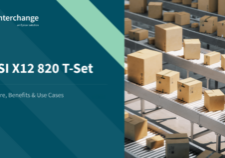4 Challenges Facing the Logistics Industry and How to Overcome Them
Global supply chains rely on the logistics industry to deliver — no other sector plays such a pivotal role in the supply and circulation of goods. Despite advancements in technology and infrastructure, the logistics industry is under constant pressure from new and existing challenges.
The COVID-19 pandemic exposed supply chain weaknesses, with 93% of supply chain executives intending to increase their supply chain’s agility and resilience.1 There is also a renewed appetite for digitisation. However, 50% of transport and logistics companies say that a lack of digital tools and training is preventing them from fulfilling their digitisation goals.2
In this article, we’re going to look at some major challenges in the logistics industry and how you can overcome them with electronic data interchange (EDI).
Let’s get started.
Suggested reading: Check our our free eBook Agile Supply Chain if you want to learn more about overcoming disruption using EDI
1: Increased demand for visibility
In recent times we have seen an increase in demand for shipment visibility and real-time tracking in both B2B and B2C. As many as 40% of customers think delivery is crucial to customer satisfaction in eCommerce, and 93% want updates on their deliveries.3
As a result, Internet of Things (IoT) sensors and GPS updates have helped establish delivery tracking. However, other practical and technological bottlenecks still prevent businesses from obtaining the desired level of visibility. For example, visibility might be manageable on a regional scale, but problems arise when negotiating purchases and contracts across different jurisdictions.
One thing is certain, and that is that supply chain visibility is a significant market opportunity. Logistics companies that can provide enhanced visibility possess a competitive advantage over those that cannot.
How EDI can help
EDI plays a fundamental role in supply chain visibility. Firstly, businesses and organisations can maintain tight control of shipping-related documents by digitising shipping paperwork, thus preventing avoidable errors from holding up shipments. EDI also makes the process of sending and receiving documents across different jurisdictions far simpler, alleviating regulatory bottlenecks.

Businesses can migrate a variety of shipping and delivery documents to EDI for real-time transfer, including:
- Advance ship notice
- Customs documents
- Inventory documents
- Invoices and payment documents
- Purchase orders
- Shipping details
- Shipping updates
Removing manual labour from the delivery process reduces human error, accelerating the movement of goods in the process. As a result, the chances of inventory problems are reduced significantly, thereby increasing cash flow.
2: Prioristing sustainability
Companies across different sectors are focusing much more on sustainability than they were just a few years ago, logistics included. Supply chains are now playing an integral role in helping businesses fulfil their sustainability promises to customers and investors.
A survey of 250 global shipping and logistic companies found that investment in sustainability is not just an ethical exercise, but that sustainable practices deliver improvements across KPIs. This includes cost savings (67%), reputational benefits (59%) and industry leadership (52%).4
Reducing emissions is central to tackling sustainability in logistics, but maximising time and cost savings through supply chain management is also crucial. For example, the Just-In-Time (JIT) approach minimises the time, money, and material cost of maintaining inventory, and improved delivery visibility provides opportunities for route optimisation.
How EDI can help
Improvements in end-to-end supply chain efficiency reduce energy costs and emissions while boosting credibility. Firstly, EDI eliminates the need for paper documentation — representing a major improvement in sustainability for larger businesses, especially those with high paperwork demands.
Beyond that, modern EDI introduces the necessary data infrastructure required to create an effective JIT supply chain. EDI links suppliers and purchasers, ensuring that documents and data are swiftly delivered and received quickly — this is fundamental to JIT.
#3 Building stronger partner relationships
Logistics is a fast-moving industry involving an abundance of providers and suppliers, making strong long-term partner relationships crucial. As well as an increased demand for internal managed file transfers between internal systems, businesses are increasingly having to deliver these reliable and secure data sharing procedures to meet trading partner requirements.
Furthermore, there are numerous examples of purchaser-supplier relationships breaking down due to a lack of communication. One of the most prolific was when Apple pressured GT Technologies into a screen manufacturing contract before changing the terms before GT was able to act to save their business. Poor communication and inefficiency compounded issues, and the company later filed for bankruptcy.5
What this demonstrates is that forming strong supply chain relationships at all levels is critical. Developing transparent relationships increases efficiency and avoids nasty surprises in today’s competitive environment.
How EDI can help
EDI is mutually beneficial across the supply chain. Deploying EDI reduces delivery times and enables suppliers to move stock faster, increasing their cash flow and reducing dependency on warehouse space.
Suppliers and purchasers that deploy EDI have more market opportunities because they’re more attractive business partners. EDI enables them to ‘plug in’ to partner’s infrastructure with minimal systems and processes restructuring. Not only does this streamline essential business processes, but it also forms a value proposition in itself.
#4 Adapting to the post-COVID world
The global impact of COVID needs little introduction, with companies across almost every sector feeling the impact. While there were both winners and losers in business, few were able to escape without adapting.
Rising fuel prices and other cost increases were among the major impacts felt by businesses, particularly the rise in freight costs as aviation ground to a halt. In addition, truck driver shortages further highlighted how COVID compounded other logistical challenges in an increasingly complex regulatory landscape.
In the wake of the pandemic, planning, digitisation and restructuring of supply chain infrastructure emerged among the chief methods for recovery and resilience in the face of future disruption. Adaptation is no longer optional for the transportation and logistics industry.
As well as addressing the points above, businesses must seek innovative solutions to their supply chain woes, including the adoption of cutting-edge cloud-based EDI solutions.
While legacy EDI solutions undoubtedly fulfil their role by facilitating data interchange in established supply chains and networks, modern approaches allow businesses to access cutting-edge EDI tools with minimal disruption.
Developments in EDI have alleviated the bottleneck of protocols and standards, enabling documents and data to pass securely between businesses. In addition, streamlining two-way communication across supply chains enables optimisation and simplification of trade partnerships, increasing logistical agility and resilience.

Overcome challenges and increase efficiency with Data Interchange
The logistics industry has utilised EDI for decades to simplify operations. However, the industry now needs a solution that provides efficiency and solves challenges to deliver a competitive advantage in a fierce business environment.
That’s why at Data Interchange we developed EDI-as-a-Service, a hybrid approach to EDI that rectifies many of the deficiencies within legacy systems. This approach brings together on-demand managed services and cloud-based tools, allowing more businesses to make the most of the benefits EDI has to offer.
On top of helping businesses overcome the issues we’ve explored above, EDI-as-a-Service offers a range of benefits in logistics. These include:
- Increased supply chain visibility: Utilise a single source of truth and get immediate access to all supply chain documents, enhancing visibility across the entire supply chain.
- Enhanced flexibility: Managed support ensures that businesses can access the expertise and flexibility necessary to adjust to new and emerging challenges the industry faces.
- Removing barriers: Overcome EDI implementation issues with a solution that accommodates a range of standards and protocols, cutting adoption times and simplifying the onboarding of partners with minimal EDI experience.
As we have seen above, EDI has a crucial role to play in solving supply chain problems in the logistics industry. Get in touch with our team today and find out how Data Interchange could help your business.
1Companies have a range of options for improving resilience
2PWC -The future of the logistics industry
4Businesswire – 81% of Companies More Focused Today on Sustainability than Three Years Ago



























































































































